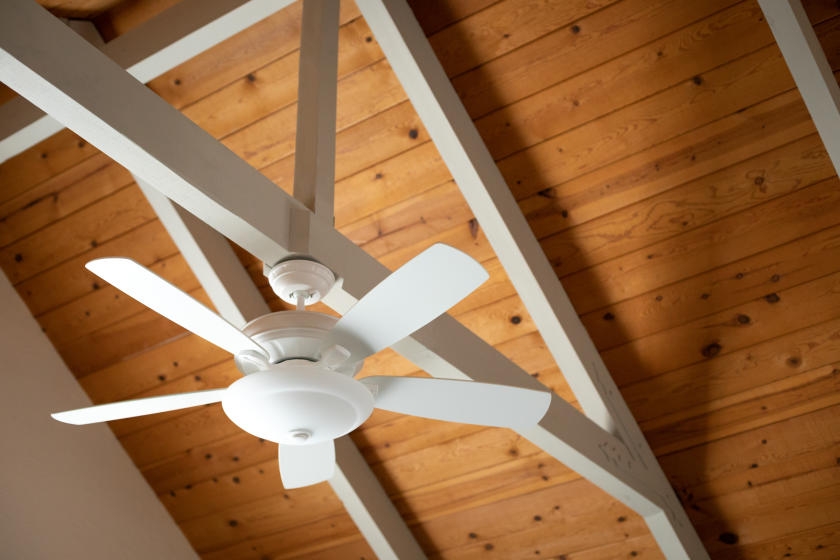Updating a ceiling fan is often part of a room makeover or remodel. You don’t have to replace the fan though. You can simply refurbish it with a coat of paint to match your room’s new look. Keep reading for tips on how to put a new spin on an old, dated ceiling fan.
Step 1: Disassemble the Fan
Start by detaching the fan from the ceiling and take it apart to paint it. Turn off power to the fan at the circuit breaker or fuse. Verify that power is off on the circuit by using a circuit tester. Only then is it safe to remove the fan and touch the wiring. Use a stepladder to safely reach the fan.
Safety Alerts!
Make sure the circuit is truly “dead” before touching any wires or terminals. Check with a high-voltage neon tester after you have detached the fan motor assembly from the ceiling. Test from the black wires to a grounded metal box or other good ground, then to the white wires. Also, test from the white wires to a ground. Be sure your tester is functioning by first trying it in a live receptacle
Enlist an assistant to help you with removing the fan from the ceiling.
Before detaching the fan from the ceiling, remove the light kit, if your fan has one. This will help ensure you don’t break any fragile shades or bulbs. Remove the light shades by either unscrewing their screws with a screwdriver or by undoing the thumbscrews, depending on the model of fan. Take the bulbs from their sockets.
Now detach the fan from the ceiling. Slide the ceiling cover down and then unscrew the screws holding the motor assembly to the hanger bracket in the ceiling. Now you should be able to access the wiring. Untwist the wire connectors for each wire connection while your assistant holds the fan. Then disconnect the fan wires from the junction box wiring. Come down from the ladder and set the fan on a worktable to continue your project.
Continue disassembling the fan. Remove each blade from the motor housing and set them aside. Also remove each blade from its bracket or cover the brackets with painter’s tape.
Step 2: Clean the Parts
Use an all-purpose household cleaner and a damp rag to completely clean all fan parts and surfaces. Ceiling fans get dusty and will most likely be caked with dust, debris and grime. You don’t want to paint over that. Clean and scrub all parts that you plan on painting. Set them aside and let them dry off completely.
Step 3: Prepare It for Painting
Prepare for painting by first setting up a workspace and prepping the parts to be painted. If possible, work outside for ventilation and to protect inside surfaces from paint. If you will be working indoors, choose a well-ventilated space such as a garage or workshop. Cover your worktable and the surrounding floor with a drop cloth or use taped-down newspaper to protect the table.
If your fan blades are made of wood, lightly sand them with fine-grit sandpaper to further remove any leftover grime and to prepare their surfaces for painting. Wipe off sanding dust with a cloth.
Step 3: Paint
Now it’s time to paint the ceiling fan. Start with the blades. Use a quality spray paint such as EasyCare® Premium Décor Spray Enamel, available in flat, satin and gloss finishes, and in multiple colors, including fluorescent and metallic (perfect for updating metal fan parts.
Hold the can about eight to 12 inches from the fan parts and keep the can moving to avoid excess paint that can drip. Apply several light coats. Let the paint dry for at least 24 hours before reinstalling the fan.
Helpful Tip
Be sure to mask any fan parts that you don’t want to get paint on.
For best results, apply a second coat of paint within one hour of applying the first coat.
After using aerosol paints, tip the can upside down and depress the nozzle for a few seconds until paint stops coming out. Next, wipe off the nozzle with a cloth. This prevents the nozzle from being clogged the next time you use the can.
Step 5: Reassemble and Reinstall the Fan
Reassemble the fan parts and then enlist your assistant again to help hold the fan while you reconnect the fan wires to the house wires. Connect the black house wires to the black fan wires and the white house wires to the white fan wires. The fan should be electrically grounded to the metal junction box. The grounding wires will be either green or bare copper. Twist the wire ends together using your fingers or needle-nose pliers. Twist a wire connector over each connection to secure it and wrap electrical tape around the connector to further secure the connection. Push the wiring into the junction box and reattach the fan to the ceiling hanger bracket. Slide the ceiling cover up and tighten it in place.
Return power to the ceiling fan at either the circuit breaker or the fuse box. Then turn on the fan to be sure it operates properly.
Great job! You essentially got a new ceiling fan without the cost.
Project Shopping List
Here’s what you’ll need to complete this project successfully.












